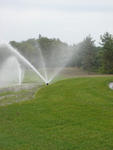
Features
Profiles
Award shows irrigation industry today ‘makes every drop count’
March 9, 2010 By Lorne Haveruk
On Jan. 12, 2010, I was honoured with the Water Conservation Award for
2009 (presented in Toronto during Landscape Congress 2010).
Unbelievable and deeply humbled for receiving an award for doing what I
do…and over the past 20 years have come to love to do. When I see what
can be achieved through education and application of the excellent
irrigation water saving devices produced by the manufacturers of
irrigation-related products, I wonder why others do not do the same. 
Irrigation in Canada has been around for hundreds of years, if not thousands. Simple dirt channels used to divert water from a given path to a path more beneficial to growing food is an example of a very early use. Large irrigation has been the norm, primarily utilized for crop watering throughout drier regions of Canada, namely the Prairie Provinces.
“Go big or go home” used to be the motto of the irrigation industry. My award shows that the irrigation industry has changed to one of “making every drop count.”
I did not do this alone and wish to acknowledge the Landscape Ontario Irrigation Commodity group, Hunter Industries, Rain Bird, Canada Turf and Toro for their contributions and time. One LO summer student by the name of Tom has become knowledgeable with irrigation by working alongside members, especially Neil Whitehall from Watertight Home Services Irrigation Division and John Lamberink of Aquality Irrigation who donated time, expertise and labour to make these installations possible. Rodnie Johnson of IPS and a few other members came to learn and help with the installation—all contributing their part to a successful, highly water-efficient, plant-specific irrigation installation that took place over a period of three weeks.
This award was given based on three different irrigation systems that I designed, organized and oversaw the installation of this summer at Landscape Ontario’s site in Milton. Three types of systems have been installed. Point source low-volume irrigation components provided by Rain Bird, supported by Vanden Bussche, now waters the perennial plants in the front entrance planter island. The difference is that each of the more than 150 perennial plants has its own emitter buried at 250 millimetres, making it difficult to see that irrigation has been installed… great for sites that experience vandalism.
John Deere and Hunter provided the product for the same location subsurface annual plant bed irrigation system. The Hunter drip line is buried at 100 millimetres depth. This provides water to the plants roots through capillary action and is virtually an unseen system. A new Hunter DC (battery) multi-station controller (no power, no problem) was combined with a rain sensor to prevent watering in the rain, saving 12 per cent or more of the water, plus not drowning the plants by overwatering.
Toro, with the assistance of Turf Care, provided an exciting new spray sprinkler nozzle known as Precision Series H20 chip technology spray nozzles. These nozzles use less water to provide hyper streams of water that oscillates back and forth inside a specially-designed chamber without any moving parts. The results are reduced runoff, lower water use and very uniform coverage. The results are complete umbrella coverage of water—and as LO past president Franz Peters of Humber Nurseries noted, “fantastic coverage,” when I demonstrated the system for him.
If you know, work, design, maintain, or do anything with irrigation or in case of LEED where irrigation is not required…here is your challenge. If you are not current with irrigation product, technology like SMART ET controllers, wireless rain sensors, in some cases wireless station valves, single-site computer control systems, Internet-based irrigation system water management, or just how to effectively schedule the irrigation system you manage…it’s past time to “GET SMART ABOUT WATER.”
At LO for all to drop in and see, play, start up and investigate how the system works (just don’t reschedule as they are weather-based control systems), are systems that make ever drop count. The point source system uses around 70 gallons of water per week, compared to a spray system to water the same plants consuming 2.700 gallons…a big difference.
So, why did I receive the award and not everyone in the irrigation industry who have worked so diligently over the past 20 years to bring irrigation from the Stone Age to the space age? I guess the award goes to the lead person. I in turn am re-awarding the Water Conservation Award for 2010 to everyone who strives to take irrigation to the next level by being actively involved in the irrigation industry and supporting their local associations. If you are one of these people…congratulations. If not, what are you waiting for? Get involved with your local irrigation group today and you, too, will be a winner.
Lorne Haveruk, CWCM-L, CID, CIC, CGIA, CLIA, WCP, Principal, DH Water Management, is one of the country’s leading irrigation consultants, focused on all aspects of water resource management (planning, design, consult, project management, and education). For additional information, visit www.dhwatermgmt.com. To contact the author directly, email lorne@dhwatermgmt.com.
Print this page